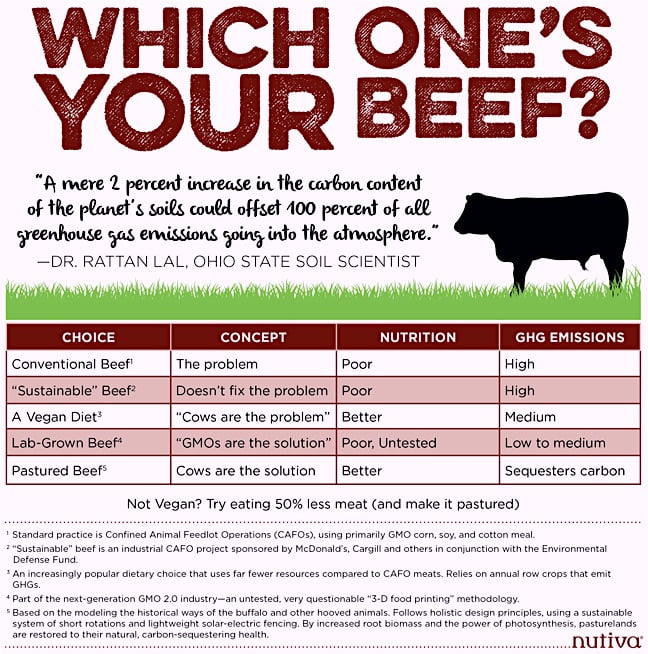
Many of us are now choosing to eat holistically grown foods. We want:
• to avoid toxic pesticides and GMOs.
• to create safer conditions for farmers and rural communities.
• to protect the water, air and soil from contamination by toxic agrochemicals.
By John Roulac in EcoWatch
While these reasons are important, one critical issue is missing from today’s conversation about food. The concept is simple, yet virtually unknown. The solution to our global food and environmental crisis is literally under our feet.
If you take away only one thing from this article, I want it to be this quote from esteemed soil scientist Dr. Rattan Lal at Ohio State University:
“A mere 2 percent increase in the carbon content of the planet’s soils could offset 100 percent of all greenhouse gas emissions going into the atmosphere.” – Dr. Rattan Lal, Ohio State Soil Scientist
Through the past hundred years, we’ve steadily increased our rate of digging up and burning carbon-rich matter for fuel. This is disturbing the oceanic ecosystem in profound ways that include reducing the plankton that feeds whales and provides oxygen for humans. And we’re not just talking about the extinction of whales. As I’ll detail in this article, even Maine lobsters could become a relic of the past.
We’ve severely disrupted the balance in the “carbon triad” by clearing rainforests, degrading farmland, denuding pasturelands, and burning coal and oil. The carbon triad? Yes; think of the three main carbon sinks: the atmosphere, the oceans and the humus-sphere. While I’m sure you’re familiar with the first two, you might not know about the latter carbon sink. Humus is the organic component of soil. (Gardeners create it as compost.) The humus-sphere is made up ofthe stable, long-lasting remnants of decaying organic material, essential to the Earth’s soil fertility and our ability to grow nutrient-rich crops.
Up until now, the big oil companies Exxon, Chevron and Shell have been perceived as the main climate villains. Yet a new and growing movement of “carbon cycle-literate” people and organizations now realize that Monsanto, DuPont, Syngenta and big ag are much worse. We now know that 20-30 percent of all manmade green house gases in the atmosphere comes from industrial agriculture. Chemicals are for cars, not for the soil. By dumping agricultural chemicals onto our soils, we disrupt nature’s delicate balance of water, soil and air.
In his recent Huffington Post piece “Nature Wants Her Carbon Back,” Larry Kopald writes, “How is it possible that with the entire planet focusing on reducing CO2 emissions we’re not even paying lip service to the single largest contributor?”
Tom Newmark, ex-CEO of New Chapter and co-founder of the Carbon Underground Project, has said it best: “Many NGOs view carbon and agriculture as the ‘enemy.’ The regenerative movement sees carbon as our friend, and agriculture as our natural ally to help our friend carbon return to the land.” The challenge is that the enemies of all things natural, i.e., Monsanto, DuPont and Syngenta, are culture jamming in hope that the regenerative message won’t go viral.
Two of those three carbon sinks are maxed out, while the soil, where the humus-sphere resides, has lost most of its humus due to the use of industrial farming techniques and bad land-management practices. This leaves the soil as the primary sink where our excess carbon can be sequestered. Yet nature is abundant and forgiving. Recent research in the fields of wetland, pasture, forest and crop production has illustrated that, by changing our management strategies, we can create more nature-centric systems that improve our quality of life rather than degrading it.
Carbon Farming Defined
Carbon farming is an agricultural system implementing practices that improve the rate at which CO2 is removed from the atmosphere and converted to plant material and/or organic matter in the soil. Today excess carbon is falling into our oceans and creating acidic conditions that threaten plant and animal species. If we remove carbon from the atmosphere and oceans by implementing the practices of regenerative organic agriculture, we’ll sequester carbon into the soil and expand the soil’s water-holding capacity. Building organic matter into the soil’s humus layer is essential for growing the healthful foods humanity needs.
As a 2014 Rodale Institute report states, “Organically managed soils can convert carbon CO2 from a greenhouse gas into a food-producing asset.” Two major upsides to this approach are drought-proof soils and, thanks to more nutrient-rich foods, reduced healthcare costs.
If this is the first you’ve heard about this idea, it’s because the good news is just starting to trickle out. For example, the Marin Carbon Project’s work with compost and rangeland was recently featured on the cover of the San Francisco Chronicle.
The mission of the Carbon Cycle Institute (part of the Marin Carbon Project) is “to stop and reverse global warming by advancing natural, science-based solutions that remove atmospheric carbon while promoting environmental stewardship, social equity and economic sustainability.” The institute is also focused on carbon-cycle literacy, a form of savvy still greatly lacking in the general population, by educating and empowering people to make more informed choices and to demand that elected officials do the same.
Recently the American Carbon Registry, a nonprofit organization that creates protocols for carbon usage, approved standards that would reward ranchers for land practices that sequester carbon. Rancher John Wick, a Carbon Cycle Institute founder, has said, “Our proposal is that there is a whole other paradigm—that agriculture practices can be . . . the art of transforming atmospheric carbon into biospheric carbon.” As of this writing, I understand that Gov. Jerry Brown’s office plans to visit Wick’s ranch.
From the regenerative agriculture movement has also come a fascinating new book by Kristin Ohlson that I strongly recommend: The Soil Will Save Us: How Scientists, Farmers and Foodies Are Healing the Soil to Save the Planet.
Chemical Ag Is the World’s Leading Problem, and—Yes—We Have an App for That
We know our oceans are polluted by chemical fertilizer runoff from industrial agriculture, which has caused more than 500 dead zones such as the Mississippi Delta. Even more disturbing is the rarely acknowledged fact that chemical fertilizers and confined animal feedlot operations(CAFOs) give off more greenhouse gases (GHGs) than all transportation methods combined. As this carbon falls into the sea, our oceans’ pH balance is thrown off.
On Nov. 14, 2014, the Canadian CBC News reported on the alarming issue of the rise in ocean temperatures, quoting Kevin Friedland, an oceanographer with the National Oceanic and Atmospheric Administration’s National Marine Fisheries Service in Narragansett, R.I., as saying: “For the northeast shelf, that summer half of the year will increase on the order of two months.”
Scientists are actively investigating another potential effect of warmer temperatures that’s happening right now—a dramatic dip in the spring bloom of phytoplankton in the Gulf of Maine: “In 2013, the spring bloom was so poorly developed it was below detection thresholds used by scientists.”
Did you know that two out of every three breaths you take come via ocean phytoplankton? And that phytoplankton is currently in steep decline due to ocean acidification? Many researchers think that within only a few decades planet oxygen levels will have dropped dramatically. As National Geographic has reported, “… relatively new research is finding that the introduction of massive amounts of CO2 into the seas is altering water chemistry and affecting the life cycles of many marine organisms.” Remember: plankton is the main food source for whales. Thus, as the plankton dissipates, the whales will disappear.
Unfortunately, the government, the media and even climate-change groups are quiet on this vital issue. The silence is perplexing. All the regulatory agencies of the federal government, and even the alternative media, have so far failed to bring to the fore this concern. It’s time we focused on soil, not oil.
On a note of hope, the United Nations, on its Dec. 5, 2014, inaugural World Soil Day, called for 2015 to be the International Year of Soils. Also, acclaimed author Michael Pollan recently gave a keynote speech (see below) at the New York Times Food for Tomorrow conference (Pollan’s key points are summarized in the last 5-6 minutes) in which he stated: “There are two faces of the climate-food system connection: how food is a key driver of climate change, responsible for between 20 to 30 percent of greenhouse gases, and then the very hopeful research on how changes in agriculture hold the potential not just to mitigate these impacts, but to actually help remove carbon from the atmosphere in large quantities. Climate change changes the ‘how to feed the world’ question in important ways, rendering many of the traditional arguments—for higher productivity at all costs—moot.”
Another positive venture is the XPRIZE Ocean Health project, a two-million-dollar global competition challenging teams of engineers, scientists and innovators (even surfers and schoolkids) all over the world to create and use pH sensor technology that will “affordably, accurately and efficiently” measure ocean chemistry. They’re testing 18 technologies for use in a new Cloud-based app to provide real-time monitoring of oceans. The Culver City-based group is funded in part by Microsoft cofounder Paul Allen and Tesla and SpaceX founder Elon Musk, and the pH sensor project is headed by Wendy Schmidt (the wife of Google executive chairman Eric Schmidt).
As chemical companies, the oil industry and the media ignore the fact that our oceans are becoming more acidic from excess carbon, Terrie Klinger, Professor of Marine Affairs at the University of Washington, comments, “We can attribute the problems in the oyster hatcheries to the increased carbon in the ocean.” The acidification of the seas is also especially detrimental to organisms, such as coral reefs, that secrete shell material.
Recently the state of Maine received a state-mandated report that appeared in Maine’s Press Herald article of Dec.1, 2014, titled “Study committee calls for Maine to act on ocean acidification.”
An excerpt: “Maine should increase research and monitoring into how rising acidity levels in oceans could harm the state’s valuable commercial fisheries, while taking additional steps to reduce local pollution that can affect water chemistry.
“The Legislature created the commission this year in response to concerns that, as atmospheric carbon dioxide levels have risen, the oceans have become 30 percent more acidic because oceans absorb the gas.”
Researchers are concerned that organisms that form shells—everything from Maine’s iconic lobster to shrimp and the tiny plankton that are key links in the food chain—will find it more difficult to produce calcium carbonate for shells in the more acidic seawater. They worry that the acidification could intensify as carbon levels rise and the climate warms.
China, India and Indonesia are creating dozens of new coal-burning power plants. In fact theWall Street Journal recently reported that India plans to double the number of coal plants by 2020. If we fail to correct the course we’re on, this proliferation of carbon will destroy not only oyster and crab populations but also the phytoplankton that provides more than 60 percent of all oxygen on the planet. While these issues are complex, simply changing your diet is one of the most powerful counteractive measures you can take.
We now know that 20-30 percent of manmade greenhouse gases in the atmosphere comes from industrial agriculture. Petrochemicals are for cars, not for the soil. By dumping ag chemicals onto our soils, we disrupt nature’s delicate balance of water, soil and air.
Carbon sequestration land practices include agriculture, forestry, wetland and range management systems that improve the rate at which CO2 is removed from the atmosphere and converted to plant material and/or organic matter in the soil. Today excess carbon is falling into our oceans and creating acidic conditions that threaten plant and animal species. If we remove carbon from the atmosphere and oceans by way of regenerative organic agriculture practices, we will sequester carbon into the soil and expand the soil’s water-holding capacity. Building organic matter into the soil’s humus layer is essential for growing the healthful foods humanity needs.
As National Geographic has reported, “… relatively new research is finding that the introduction of massive amounts of CO2 into the seas is altering water chemistry and affecting the life cycles of many marine organisms.” This is disturbing the oceanic ecosystem in profound ways that include reducing the plankton that feeds whales and provides oxygen for humans.
The 2014 Rodale Institute report states, “Organically managed soils can convert carbon CO2 from a greenhouse gas into a food-producing asset.” Two major upsides to this approach are drought-proof soils and, thanks to more nutrient-rich foods, reduced healthcare costs.
Foodies, Unite!
Luckily, bloggers, activists and the booming pure food movement hold the promise of positive change. We need a coalition of educated and empowered people to make good dietary choices that also support living soils. Organic, nutrient-dense foods might cost more (buying in bulk helps), yet we can see how costly poor food choices are for our national health. And, as in the civil rights movement or any progressive movement for change, it’s time for us to stand up and make our voices heard. Keep blogging, tweeting, Pinteresting, Instagramming and posting on Facebook, as sharing is caring.
The San Francisco-based Biosafety Alliance will hold a major conference on carbon farming andclimate change in Richmond, California, in September 2015, featuring such speakers asVandana Shiva and Ronnie Cummins. The ministers of propaganda at Monsanto and other chemical companies are amping up their own social media campaigns, to tell us how they’re going to feed the world and increase food security through genetically engineered foods and chemical agriculture. Sales are down or flat for virtually every major American food company, so they’re spending hundreds of millions of dollars to fortify their misleading advertising and public relations campaigns.
Courtney White in his book Grass, Soil, Hope: A Journey through Carbon Country writes: “It is easy to forget that once upon a time all agriculture was organic, grass-fed and regenerative. Seed saving, composting, fertilizing with manure, polycultures, no-till and raising livestock entirely on grass—was the norm, not the exception as it is now.
“We all know what happened next: the plow, the tractor, fossil fuels, mono-crops, nitrogen fertilizer, pesticides, herbicides, fungicides, feedlots, animal byproducts, e. coli, CAFOs, GMOs, erosion, despair—practices and conditions that most Americans today think of as ‘normal,’ when they think about agriculture at all.”
As delicate ecosystems are disrupted, and plant and animal species face extinction at an ever-increasing rate, the word is getting out that the current practices of chemical companies and industrial agriculture are harming billions of people.
Recently, large investment funds have responded to disinvestment advocates by selling off their holdings in Exxon, BP, Chevron and other carbon polluters, yet they still invest in Monsanto—a group that transgresses far beyond any oil company in its injury to the environment and society.
It’s time for everyone who cares about the future of food to unite in changing the failing industrial agriculture system. We have the opportunity to vote three times a day by eating organic whole foods instead of packaged, processed and convenient “food-like substances.” Vegans, it’s vital that you choose organic foods vs. Roundup-sprayed, hexane-processed soy cutlets. The fake, non-organic foods funded by the Silicon Valley are not life-enhancing. For those who eat meat, eggs and dairy products, it’s important to support pasture-based ranchers and suppliers, as these systems sequester carbon into the soil humus-sphere through intensive grazing. Meat eaters consider consuming 50 percent less meat, and at all costs we must avoid conventional suppliers that rely on toxic, high-GHG chemical fertilizers to grow carbon-intensive GMO corn and soy.

Industrial agriculture regards soil as merely a root-holding medium on which to apply petroleum products while manipulating genetics. Regenerative organic agriculture views soil as a holistic system, and understands the interconnected soil biology—teeming with the billions of bacteria and fungi that, along with earthworms and organic matter, indicate good health. Healthy soil yields healthy foods that, in turn, nourish a healthy society. Los Angeles-based Kiss the Ground Foundation is working on a powerful, new, five-minute Story of Soil video to educate the public on this vital issue.
Using short rotation with solar-powered mobile fencing, a new generation of ranchers is growing grass while building carbon and organic matter into the soil. The 12-minute video Soil Carbon Cowboys featured one such “grass rancher,” Gabe Brown, who increased the organic matter in his North Dakota pastureland from less than 2 percent to 8 percent in 20 years.
For annual crops, planting rotational cover crops like vetch or alfalfa, instead of using nitrogen fertilizers, is essential. Chemical nitrogen fertilizers release massive amounts of nitric oxides that are nearly 400 times worse than carbon dioxide. Some organic CAFO producers such as Horizon Organic Milk are clearly not regenerative, as they rely on factory farms to produce a large percentage of their milk.
The U.S. Department of Agriculture and U.S. Environmental Protection Agency statistics vastly underreport agriculture emissions at 10-12 percent total. Many researchers think agriculture is the source of more of these emissions than even transportation fuels. Organic is better than conventional, but organic plus regenerative is best, for it enhances soil fertility vs. merely maintaining it. (A big reason why the return of hemp farming is so vital is hemp’s deep taproot and nitrogen-rich leaves that build soil tilth).
Yet, as Tom Newmark of regenerative farming group the Carbon Underground says, “We need to both move forward in building soil life and conduct more science around carbon sequestration to share with policymakers and allies.”
The Way Forward
Many in the organic movement wonder about our NGO allies in the climate, ocean and forestry sectors. According to Ronnie Cummins of the Organic Consumers Association, “With the mounting evidence of how regenerative organic agriculture is the number one solution for climate change, ocean health, and soil ecology via sequestering carbon, it’s time for the environmental movement to join forces. In fact, our survival depends on it.”
Trying to solve the entire problem by reducing global carbon via solar, wind and renewables has been a failure. One climate meeting after another ends with people throwing up their hands and declaring that we’re doomed because nations won’t agree to meaningful cuts. The message of drawing down carbon via regenerative agriculture warrants no mention in the glossy documents, nor even a tweet!
A recent Cummins “Letter from Lima” provides interesting background on the climate movement.
Yet a groundswell of people are beginning to realize that the way forward is to support regenerative organic farming and pasture-raised meat and dairy systems while simultaneously reducing animal consumption. As the Earth passes the 400-ppm carbon mark, noted author and environmentalist Paul Hawken declares, “Stabilization at 450, 500, 550 ppm is chaos—our goal should be drawdown.”
Which is better for the environment—to buy a Tesla and consume a standard American diet or to drive a used SUV and eat an organic diet with some pastured meat and dairy? Yes, it’s the latter, and of course even better is to eat an organic diet, walk or bike more, and drive a more energy-efficient car.
Soil, not oil, is the wise path forward. At the height of this information age of Google and the social media, the history of our planet is being written. Will it ultimately be said that the simple solution under our feet was shared around the digital campfire, and thus globally chosen by informed citizens of the Earth? Or will the annals read that this saving solution was ignored by all but a few? Did the 7 billion people on Planet Earth succumb to false messages from Monsanto, Exxon and self-serving apologists that GMO “better living through chemistry” food systems were best?
As you read this, a new generation of GMO 2.0 untested synthetic foods is being programmed in labs via “3-D food printing.” The fate of Earth’s life-support systems is hanging in the balance. Remember, as you start to reach for that box of non-organic cereal for your shopping cart: What we eat will impact the planet more than just about anything else we do. It’s late in the fourth quarter and there are no timeouts left, but—yes—we have the ball.
It’s time for us to revive the ancient wisdom of honoring the land, and in the process heal our atmosphere, our oceans, our humus-sphere and ourselves. Regenerative organic agriculture is the answer we need to create a food system that works for everyone. Are you ready to be part of this solution?
John W. Roulac, founder and CEO of the superfoods company Nutiva, has also founded five nonprofit ecological groups, including GMO Inside and the Nutiva Foundation. John has written four books, including Backyard Composting and Hemp Horizons.
Disclaimer: We at Prepare for Change (PFC) bring you information that is not offered by the mainstream news, and therefore may seem controversial. The opinions, views, statements, and/or information we present are not necessarily promoted, endorsed, espoused, or agreed to by Prepare for Change, its leadership Council, members, those who work with PFC, or those who read its content. However, they are hopefully provocative. Please use discernment! Use logical thinking, your own intuition and your own connection with Source, Spirit and Natural Laws to help you determine what is true and what is not. By sharing information and seeding dialogue, it is our goal to raise consciousness and awareness of higher truths to free us from enslavement of the matrix in this material realm.
Français
 EN
EN FR
FR

























